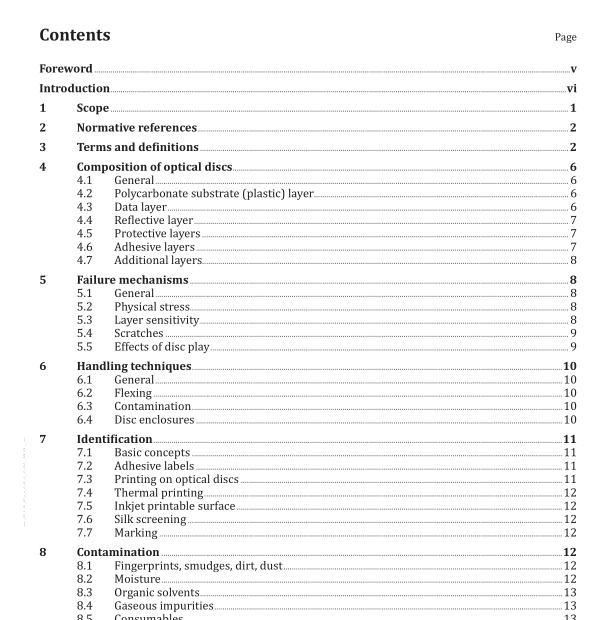ISO 18938 pdf download

ISO 18938 pdf download Imaging materials — Optical discs — Care and handling for extended storage
1 Scope
This International Standard establishes general principles for the care and handling of digital optical discs during use. It addresses the issues of physical integrity of the medium necessary to preserve access to the recorded data (information). This International Standard includes recommendations for handling procedures to maximize the effective life of optical discs. Faulty handling, packing and transporting techniques and methods often cause physical damage to the discs and to the content recorded thereon. Extending the longevity of optical discs requires the identification of appropriate handling methods, as well as well-developed and implemented training programs.
For the purposes of this International Standard, the term “optical disc” includes the families of compact disc (CD), digital versatile disc (DVD), high definition digital versatile disc (HD DVD) and Blu-ray disc (BD) 1) , and any hybrids of these families. The term “optical disc” also includes each type of disc within a family, including injection moulded [read-only memory (ROM)], dye-layer [recordable (R)] and phase change [rewritable (RW, RE), random access memory (RAM), and recordable (BD-R)] technologies.
While some of the recommendations in this International Standard (e.g. those for staff training) apply specifically to large-scale or long term usage, the basics of all recommendations in this International Standard are intended to be applied in circumstances where the desired result is long-term usage of the medium whether archival, commercial or personal.
This International Standard does not cover magneto-optical (MO) discs, laser discs (LD) or glass discs. At the time of writing, International Standards do not exist for HD DVD and Blu-ray discs. Nonetheless, it is believed that the recommendations in this International Standard for care and handling can equally apply to them. It is recognized that some of these requirements are not necessarily possible for the individual user to achieve.
The following are within the scope of this International Standard:
— use and handling environments, including pollutants, temperature and humidity and light exposure;
— contamination concerns;
— inspection;
— cleaning and maintenance, including cleaning methods and frequency;
— transportation;
— disasters, including water, fire, construction and post-disaster procedures;
— staff training.
The quality of the data written on the disc is outside the scope of this International Standard. However, a high quality result of the recording phase is important to the longevity of information. It is advisable that a rigorous program of data integrity testing be implemented, as this forms an obligatory part of all digital long-term storage. In addition, when keeping digital information for archival purposes, it is advisable that a multiple copy/multiple location strategy be in place.









